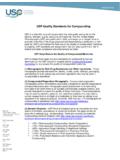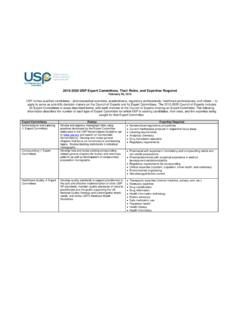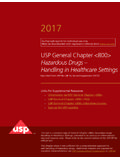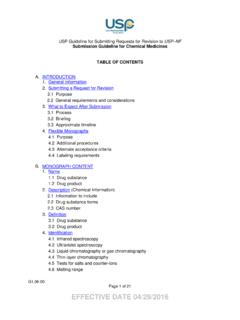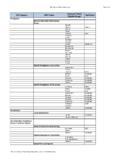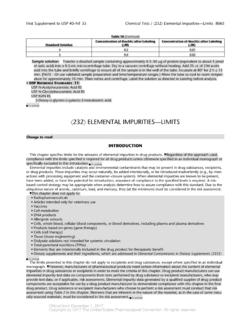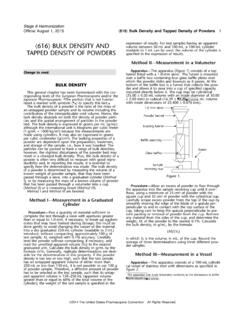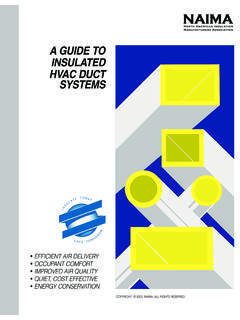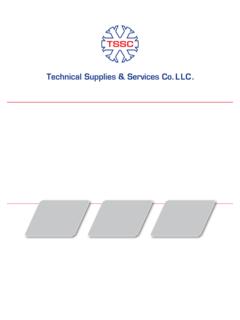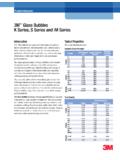Transcription of BRIEFING 660 Containers Glass, - USP
1 BRIEFING . 660 Containers glass , USP 40 page 534. The Packaging and Distribution Expert Committee is proposing the following revision to clarify the intent of the chapter and provide additional information to aid in the execution of the Surface glass Test, glass Grains Test, and Surface Etching Test. None of the proposed revisions will change the chapter's requirement. However, there will be a revision proposal in 2018 that is meant to modernize tests, test methods, and specifications within the chapter, and will be a high-impact revision. Listed below are the key changes being proposed: 1. The chapter title has been changed to glass Containers Used in Pharmaceutical Packaging/Delivery Systems.
2 2. A Scope section has been added. 3. Table 1 and Table 2 have been consolidated into one table which denotes the specifications for the Surface glass Test, glass Grains Test, and Surface Etching Test for a glass container to be classified as Type I, II, or III. 4. Additional requirements for the autoclave used for the various tests have been added to the chapter. 5. The list of ancillary equipment required to execute the chapter has been expanded. 6. The Purified Water requirement has been aligned with the Pharm Europa General Chapter " glass Containers for Pharmaceutical Use". 7. Additional information on the Autoclaving procedure has been added to the chapter, including Reference temperature curve, Autoclave calibration, and Routine autoclave runs.
3 8. Additional information on how to titrate the test and blank samples has been added to the chapter. Additionally, minor editorial changes have been made to update the chapter to current USP style. A workshop, Modernization of USP Packaging Standards for glass and Elastomeric Components, will be held June 19 20, 2017 at USP in Rockville, Maryland, to discuss this revision proposal, potential future revisions to this chapter, and the revision proposal for Evaluation of the Inner Surface Durability of glass Containers 1660 , also appearing in this issue of PF (for details of the workshop, go to the USP website courses/workshops/modernization-usp-pack aging-standards- glass -and- elastomeric-components).
4 (GCPD: D. Hunt.). Correspondence Number C144464. Change to read: 660 Containers glass glass . Containers USED IN. PHARMACEUTICAL. PACKAGING/DELIVERY SYSTEMS 1S. (USP41). Add the following: . SCOPE. DESCRIPTION. SPECIFIC TESTS. Hydrolytic Resistance Surface glass Test (Hydrolytic Resistance of the Inner Surfaces of glass Containers ). glass Grains Test (Hydrolytic Resistance of glass Grains). Surface Etching Test Impurities Arsenic 211 . Functionality Spectral Transmission for Colored glass Containers 1 S (USP41). Add the following: . SCOPE. glass packaging components are used in packaging and delivery systems for various parenteral preparations as defined in Injections and Implanted Drug Products 1 and in non-parenteral preparations.
5 glass components include, but are not limited to, ampules, bottles, cartridges, syringe barrels, and vials in both flint (clear) and colored (amber) glass . A packaging system, also referred to as a container closure system, is defined in Packaging and Storage Requirements 659 and is the sum of packaging components that together contain, protect, and in certain cases deliver the drug product. 1 S (USP41). Change to read: DESCRIPTION. glass Containers for pharmaceutical use are intended to come into direct contact with pharmaceutical products. glass used for pharmaceutical . Containers is either borosilicate (neutral) 1 S (USP41) glass or soda-lime-silica.
6 glass . Borosilicate glass exhibits a high hydrolytic and thermic resistance due to the chemical composition of the glass itself and is classified as Type I. glass . 1S (USP41) Borosilicate glass contains significant amounts of boric oxide, aluminum oxide, and alkali and/or alkaline earth oxides in the glass network. Soda-lime-silica glass is a silica glass containing alkaline metal oxides, mainly sodium oxide, and alkaline earth oxides, mainly calcium oxide, in the glass network. Soda-lime-silica glass has a moderate hydrolytic resistance . due to the chemical composition of the glass itself; it and 1 S (USP41) is classified as Type III glass .
7 Suitable treatment of the inner surface of Type III soda - . lime-silica glass Containers , for example with ammonium sulfate, 1S (USP41) will raise the hydrolytic resistance from a moderate to a high level, changing the . classification of the glass container from Type III 1 S (USP41) to Type II. The following recommendations can be made as to the suitability of the glass type for Containers for pharmaceutical products, based on the tests for hydrolytic resistance. Type I glass Containers are suitable for most products for parenteral and nonparenteral uses. Type II glass Containers are suitable for most acidic and neutral aqueous products for parenteral and nonparenteral uses.
8 Type II Containers may be used for alkaline parenteral products where stability data demonstrate their suitability. Type III glass Containers usually are not used for parenteral glass products or for powders for parenteral use, except where suitable stability test data indicate that Type III glass satisfactory. The inner surface of glass Containers may be treated to improve hydrolytic resistance. The outer surface of glass Containers may be treated to reduce friction or for protection against abrasion or breakage. The outer surface treatment is such that it does not contaminate the inner surface of the container .. glass may be colored to provide protection from light by the addition of small amounts of metal oxides and is tested as described in Spectral Transmission for Colored glass Containers .
9 A clear and colorless container that is made light resistant by means of an opaque enclosure (see Packaging and Storage Requirements 659 , General Definitions, Packaging Definitions, Light-Resistant container ) is exempt from the requirements for spectral transmission. It is recommended that all glass Containers for liquid preparations and for powders for parenteral administration permit the visual inspection of the contents. In order to support the visual inspection of the content, light protective glass should only be used if necessary for the protection of the drug. The inner surface of the container may be treated, , with a hydrophilic or hydrophobic coating, to prevent release of glass elements into the drug solution (see Evaluation of the Inner Surface Durability of glass Containers 1660 , Formation and Processing of Molded and Tubular glass Containers , Surface Treatments).
10 The outer surface of glass Containers may be treated to reduce friction or for protection against abrasion or breakage. The outer surface treatment is such that it does not contaminate the inner surface of the container (see 1660 , Surface Treatments). The following recommendations can be made as to the suitability of the glass type for Containers for pharmaceutical products, based on the hydrolytic resistance. Type I glass Containers are suitable for all products;. Type II glass Containers are suitable for most acidic and neutral aqueous products and Type III glass Containers are suitable for non-parenteral products. Type II and III Containers may be used for parenteral applications, including alkaline products, where suitable stability test data is available.
